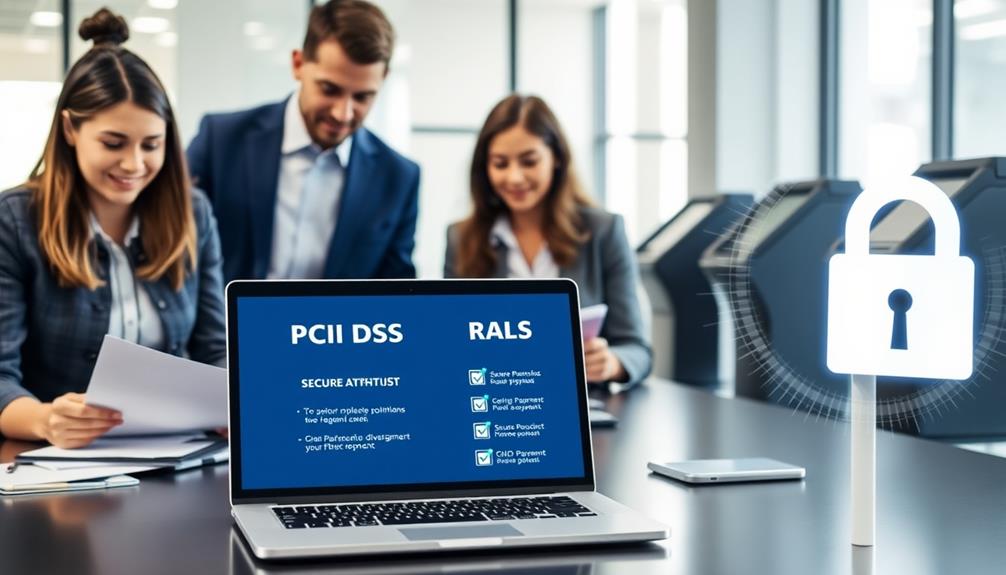To conduct a payment security audit for your business, start by evaluating your compliance with PCI DSS standards. Define the scope of the audit, covering all systems and personnel. Next, identify vulnerabilities through risk evaluations and documentation of your security controls. Engage with Qualified Security Assessors (QSAs) who can pinpoint gaps and suggest improvements. Incorporate regular monitoring and update your security measures as needed. Verify your team is trained on PCI compliance and threats like phishing. With this groundwork, you'll be well on your way to improving your payment security. There's more to this process, so keep exploring the details for better results.
Key Takeaways
- Define the audit scope clearly, covering all systems, personnel, and payment processes involved in handling cardholder data.
- Conduct a thorough risk assessment to identify vulnerabilities and prioritize remediation efforts based on potential impact.
- Engage Qualified Security Assessors (QSAs) to provide expertise, identify security gaps, and assist with documentation preparation for compliance.
- Maintain thorough documentation of security measures, incidents, and compliance activities to support audit processes and future evaluations.
- Implement regular training programs for employees on PCI DSS compliance, focusing on common threats and best security practices.
Understanding Payment Security Audits

When you're looking to protect cardholder data during transactions, understanding payment security audits is essential. A payment security audit evaluates your organization's adherence to security standards like PCI DSS, ensuring your internal controls are robust.
This process involves a thorough assessment of your security infrastructure, including encryption methods and access controls. Additionally, implementing effective fraud prevention tools during the audit can enhance your overall security framework.
Regular audits are vital in identifying vulnerabilities and gaps in your security measures. By conducting these audits, you can facilitate timely remediation and enhance overall data protection. The audit process typically includes a gap analysis, where you pinpoint areas needing improvement, followed by remediation planning to address those issues. An onsite assessment by qualified security assessors (QSA) helps verify your compliance with industry regulations.
Ultimately, a payment security audit isn't just about meeting compliance standards; it's about maintaining customer trust and preventing financial losses associated with data breaches and fraud.
Importance of PCI DSS Compliance

The significance of PCI DSS compliance for businesses can't be overstated. It's mandatory for any organization that accepts, processes, or stores cardholder data. By adhering to PCI DSS, you actively protect cardholder data and sensitive information from breaches and fraud.
This compliance helps you implement security best practices that not only safeguard your operations but also enhance customer trust in your business. In addition, maintaining PCI compliance is essential in a landscape where over 1.8 billion payment card records were compromised in 2020, highlighting the importance of robust security measures to protect sensitive information from credit card fraud.
Maintaining PCI compliance involves meeting the 12 requirements of PCI, which collectively aim to secure cardholder data. Failure to comply can lead to hefty fines, ranging from $5,000 to $100,000 per month, and could result in reputational damage that impacts your bottom line.
Furthermore, non-compliance increases your vulnerability to data breaches and could attract legal scrutiny from regulatory bodies like the Federal Trade Commission (FTC).
Preparing for the Audit Process

Achieving PCI DSS compliance sets the stage for a successful payment security audit. Start by defining the scope of your audit, identifying all systems, processes, and personnel that interact with cardholder data. This guarantees extensive coverage and helps you focus on areas that need attention.
Additionally, consider implementing a cost-effective home security system to enhance your overall data protection strategy. Next, conduct a thorough risk assessment to identify vulnerabilities and potential threats to cardholder data security, which is vital for effective audit preparation.
Gather necessary documentation, including policies and procedures, to support the audit process and verify compliance with PCI DSS requirements. Document security controls meticulously, as this will be key during the audit.
Don't overlook staff training; make sure your team understands PCI DSS requirements and their specific responsibilities related to data security. This fosters a culture of compliance and awareness within your organization.
Steps to Conduct the Audit

Start by clearly defining the scope of your audit to confirm you cover all systems, processes, and personnel that handle cardholder data. This guarantees a thorough evaluation of your payment security framework.
Given the increasing sophistication of cyber threats, it's crucial to incorporate AI security solutions to enhance your detection and response capabilities.
Next, conduct a thorough risk assessment to identify vulnerabilities and threats to cardholder data security. This step helps you prioritize remediation efforts effectively.
Gather necessary documentation, including:
- Security policies and procedures
- Access logs and transaction records
- Incident response plans
- Employee training records
These documents will facilitate a detailed review during the audit process.
You should then perform an onsite assessment with qualified security assessors (QSAs) to evaluate your compliance with security measures and PCI DSS requirements.
As you assess, document findings and areas needing improvement in a final report. Guarantee this report outlines corrective actions taken and plans for ongoing compliance maintenance.
By following these steps, you create a robust framework for protecting cardholder data while confirming your business aligns with industry standards.
Remember that ongoing compliance is critical for safeguarding both your customers and your business reputation.
Engaging Qualified Security Assessors

When you engage a Qualified Security Assessor (QSA), you're taking an essential step toward ensuring your business meets PCI DSS requirements effectively. QSAs are certified independent organizations recognized by the PCI Security Standards Council, bringing invaluable expertise to your compliance efforts. They specialize in identifying security gaps and recommending improvements, ensuring your audit process covers all necessary aspects to enhance your data security.
Their role is vital in fostering a sense of ethical decision-making frameworks that prioritize the collective good while maintaining individual rights.
By engaging a QSA, you gain a structured approach to the audit, including scoping and preparing required documentation. They'll also facilitate effective communication with your team throughout the assessment. This collaborative effort helps clarify expectations and responsibilities, making the entire process smoother.
It's important to choose a QSA with relevant industry experience and a proven track record. Their background will help tailor the audit process to your specific business needs, ensuring alignment with the latest PCI DSS requirements.
Additionally, a professional assessment and reporting from a QSA can add credibility to your compliance efforts, reassuring stakeholders about the integrity of your payment security practices. This engagement isn't just beneficial; it's a strategic move to fortify your business's stance on data security.
Continuous Compliance Monitoring

After engaging a Qualified Security Assessor (QSA), it's time to focus on continuous compliance monitoring to maintain your PCI DSS adherence.
This ongoing process is essential for regularly evaluating your security controls and ensuring compliance with PCI DSS requirements. It helps mitigate the risk of data breaches and fraud.
Furthermore, integrating effective merchant services can enhance security measures while streamlining payment processes for your business.
To effectively implement continuous compliance monitoring, consider the following actions:
- Utilize automated tools: These can provide real-time insights into your compliance status, enabling you to spot issues quickly.
- Conduct regular internal audits: Aim for at least quarterly reviews to identify any compliance gaps or vulnerabilities that may have developed since your last evaluation.
- Maintain thorough documentation: Keep records of your security measures, incidents, and compliance activities to demonstrate adherence during external audits.
- Engage with Qualified Security Assessors (QSA): Periodic reviews by QSAs can offer expert guidance on evolving threats and best practices, enhancing your monitoring efforts.
Addressing Audit Findings

Recognizing and addressing audit findings promptly is vital for maintaining the security of cardholder data. Start by prioritizing significant findings, as these pose the highest risk to your compliance efforts and overall data security.
To enhance your approach, consider integrating techniques from your overall IRA Investment Strategy that emphasize risk management and proactive measures. Develop a detailed remediation plan that outlines specific corrective actions for each identified gap. Include timelines and designate responsible personnel to guarantee accountability.
As you implement these actions, document everything thoroughly. This creates a clear record for future audits and showcases your commitment to compliance with PCI DSS requirements.
Regularly communicate with your staff about the findings and the remediation efforts. This fosters security awareness and guarantees everyone understands their role in maintaining compliance.
Don't forget to schedule follow-up assessments to verify that the changes effectively mitigate the identified risks. These assessments are vital for maintaining ongoing compliance and demonstrating that you're serious about addressing audit findings.
Creating a Culture of Security

To create a culture of security, you'll need to prioritize employee training programs that keep everyone informed about best practices.
Incorporating effective relaxation techniques can help reduce stress, allowing employees to focus better on security protocols.
Regular security assessments will help identify gaps in your defenses, while a solid incident response plan guarantees your team knows how to act when issues arise.
Employee Training Programs
Creating a culture of security within your organization starts with thorough employee training programs that highlight the critical importance of PCI DSS compliance. Each employee plays a crucial role in safeguarding cardholder data, and understanding their responsibilities can prevent costly security incidents.
Additionally, it's important to incorporate goal tracking strategies into your training initiatives to guarantee that employees are aware of their progress and responsibilities in maintaining security standards. Implementing effective goal tracking will help keep your team motivated and focused on achieving compliance.
To effectively enhance cybersecurity awareness, consider implementing these key components in your training programs:
- Regular Sessions: Conduct frequent training on PCI DSS compliance and the consequences of non-compliance, which can lead to fines up to $100,000 monthly.
- Ongoing Cybersecurity Awareness: Educate employees about common threats like phishing and social engineering that contribute to data breaches.
- Role-Based Training: Tailor training to specific job functions, ensuring employees understand their unique security protocols to minimize unauthorized access.
- Interactive Training Methods: Use simulations and real-life scenarios to engage employees, considerably boosting their retention of security best practices.
Regular Security Assessments
Regular security assessments form an integral part of your organization's commitment to safeguarding cardholder data. By conducting these assessments regularly, you can identify vulnerabilities in your payment systems and guarantee compliance with PCI DSS requirements. This proactive approach not only enhances your security posture but also instills a culture of security across your organization.
Implementing efficient payment solutions for transportation businesses can further mitigate risks by integrating security features that protect sensitive customer data.
To create this culture, implement ongoing training and awareness programs that educate your staff about the crucial nature of protecting cardholder data and recognizing potential threats. Continuous monitoring of security measures allows you to detect anomalies in real-time, enabling swift responses to potential breaches.
Establish a schedule for internal audits and risk assessments, fostering accountability among employees and making sure they understand their roles in maintaining payment security. Regularly updating your security policies and procedures based on assessment findings and changes in PCI DSS requirements is essential for sustaining compliance and improving overall security.
Incorporating these elements into your security strategy won't only protect sensitive data but also help build trust with your customers, reinforcing their confidence in your business's commitment to security.
Incident Response Planning
In the domain of cybersecurity, an effective incident response plan (IRP) is essential for swiftly addressing security incidents and minimizing potential damage. By clearly outlining roles and responsibilities, your team can respond efficiently to potential breaches.
To create a culture of security, consider these key practices:
- Regular training on security best practices: This fosters awareness and vigilance among all employees, reducing human error, which accounts for 95% of cybersecurity incidents.
- Conduct periodic reviews: Updating your IRP guarantees compliance with the latest PCI DSS requirements and adapts to emerging threats.
- Incorporate lessons learned: Use insights from past incidents to drive continuous improvement, enhancing your overall security posture.
- Focus on preparedness: Regular drills can notably reduce incident response times, which can otherwise take up to 280 days for organizations lacking a structured plan.
When you prioritize incident response planning, you not only comply with necessary regulations but also cultivate a proactive approach to managing cybersecurity incidents.
This commitment to preparedness and continuous improvement will empower your organization to tackle any security challenge effectively.
Frequently Asked Questions
How Do You Conduct a Security Audit?
To conduct a security audit, you start by defining the scope, evaluating risks, and gathering necessary documentation. Then, perform an onsite evaluation, and finally, document findings to create a report for continuous improvement.
How to Conduct PCI DSS Audit?
Think of a treasure map; each step reveals hidden paths. You'll first assess your landscape, then gather your tools. With guidance from a wise mentor, you'll chart your course, ensuring a secure journey for all.
How to Conduct PCI Assessment?
To conduct a PCI assessment, you'll identify systems handling cardholder data, perform a risk assessment, gather documentation, train staff, engage a Qualified Security Assessor, and document findings to guarantee compliance with PCI DSS standards.
Who Performs PCI Audits?
PCI audits are performed by Qualified Security Assessors (QSAs), certified experts who evaluate your compliance with PCI DSS. They identify vulnerabilities in your security practices, ensuring your organization effectively protects cardholder information and maintains credibility.
Conclusion
Conducting a payment security audit is like shining a flashlight into the dark corners of your business; it helps you spot vulnerabilities before they become major issues. By ensuring PCI DSS compliance and engaging qualified assessors, you protect your customers and your reputation. Remember, it's not just about passing the audit; it's about creating a culture of security that lasts. Stay vigilant, keep monitoring, and address any findings promptly to maintain trust and safeguard your business's future.










